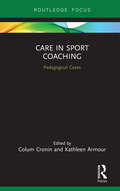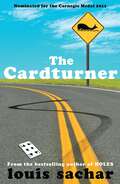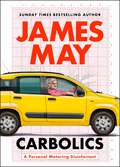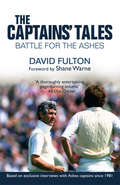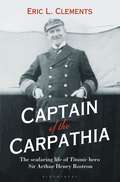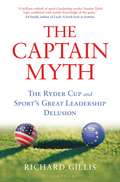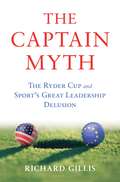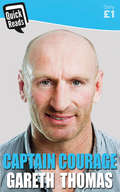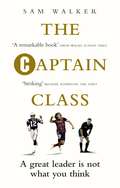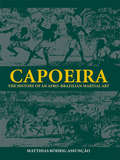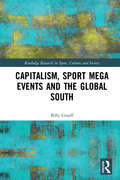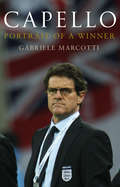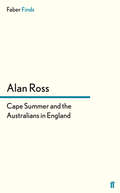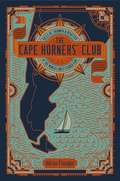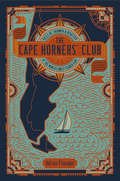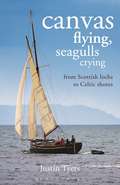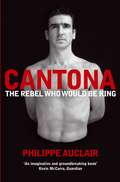- Table View
- List View
Care in Sport Coaching: Pedagogical Cases (Routledge Research in Sports Coaching)
by Colum Cronin Kathleen ArmourWhile it is accepted that sport coaches should safeguard participants, Care in Sport Coaching: Pedagogical Cases argues that coaches have a duty of care that moves beyond protection and involves the development of caring relationships with athletes. Recent high-profile incidents of abuse in sport highlight the need to reposition coaching as a caring activity and to embed care within coach education and coaching policy. Based around extended case studies, this book provides grounded accounts of how coaches care in their everyday practice. These case studies are analysed using multidisciplinary theoretical perspectives to illustrate and problematise how coaches care. Conclusions are provided, based on these analyses, that will help coach educators, researchers and policy makers establish care as a key facet of everyday sport coaching activities. Additionally, the book offers guidelines that will aid practitioners to enact care in their practice. This is important reading for coaches, researchers, lecturers and students who are concerned with the role of coaches and the development of coaching practice.
The Cardturner (Playaway Children Ser.)
by Louis SacharWhen Alton's ageing, blind uncle asks him to attend bridge games with him, he agrees. After all, it's better than a crappy summer job in the local shopping mall, and Alton's mother thinks it might secure their way to a good inheritance sometime in the future.But, like all apparently casual choices in any of Louis Sachar's wonderful books, this choice soon turns out to be a lot more complex than Alton could ever have imagined. As his relationship with his uncle develops, and he meets the very attractive Toni, deeply buried secrets are uncovered and a romance that spans decades is finally brought to a conclusion.Alton's mother is in for a surprise!
Cardiovascular Signaling in Health and Disease
by Narasimham L. Parinandi Thomas J. HundThis contributed volume focuses on cardiovascular diseases (CVDs), and explores the ways in which signaling mechanisms at the biochemical, molecular, and cellular levels in the blood vessels (vascular) and heart contribute to the underlying causes of development and progression of the CVDs. This volume covers unique topics such as oxidant signaling in vascular and heart diseases and health, cytoskeletal signaling in vascular health and disease, phospholipase signaling in CVDs, lipid signaling in vascular and myocardial health and diseases, and drug discovery in cellular signaling for cardiovascular diseases.This book assembles the most important discoveries made by leaders on the cellular signaling mechanisms operating behind the development and progression of life-threatening CVDs. It is an extremely useful resource for the investigators in the field of CVDs, and opens the discussion for further discovery of efficient management and effective treatment of the CVDs.
Cardiologia dello Sport: Diagnostica e clinica cardiovascolare
by Massimo Fioranelli Gaetano FrajeseGli adattamenti cardiovascolari dell’atleta rappresentano, a volte, una sottile linea di confine tra la fisiologia e la patologia e rendono difficile una valutazione del rischio. Se questa è una difficoltà obiettiva, amplificata dal risalto mediatico di seppur rare fatalità durante il gesto sportivo, esistono anche contesti clinici meno pubblici ma non esenti da implicazioni medico-legali. Servono quindi strumenti che consentano al medico una riflessione clinica serena. Questo volume, rivolto al cardiologo clinico, al medico dello sport e allo specializzando, tratta sistematicamente le indicazioni per una moderna diagnostica invasiva e non invasiva e le principali problematiche cardiologiche che riguardano gli atleti. Particolare attenzione è stata dedicata alle terapie più moderne: l’interventistica coronarica, la chiusura del forame ovale, le procedure in caso di pazienti con dispositivi antiaritmici e le precauzioni per l’attività fisica in atleti affetti da cardiopatie congenite.
Cardiac Mechanobiology in Physiology and Disease (Cardiac and Vascular Biology #9)
by Markus Hecker Dirk J. DunckerThis book presents the latest findings in the field of cardiac mechanobiology in health and disease.Cardiac mechanobiology provides knowledge of all aspects of mechanobiology of the heart. Cardiomyogenesis is discussed as well as the mechanobiology of cardiac remodeling and regeneration. The molecular mechanisms of mechanoperception and mechanotransduction in cardiomyocytes are explained, as well as stretch induced differentiation of cardiomyocytes derived from induced pluripotent stem cells. This volume of the series Cardiac and Vascular Biology complements the volume Vascular Mechanobiology in Physiology and Disease (volume 8) published in this series. The book is aimed at clinicians as well as researchers in cardiovascular biology, bioengineering and biophysics, and also represents an educational resource for young researchers and students in these fields.
Carbolics: A personal motoring disinfectant
by James MayWhy does a man with a Ferrari and a Porsche drive a Fiat Panda? Is going fast really necessary? Is it your fault if you get run over? Why will electric cars really save the planet (possibly)? In Carbolics the UK's favourite petrol head (after Clarkson and Hammond) James May answers these questions and more. Across 80 essays, James gives his quirky, entertaining take on cars, motorbikes, trucks - and explains why the bicycle might just be the best invention of all.Written with James's characteristic wit and humour, Carbolics is the perfect Christmas gift for petrolheads.
Caravan Cookbook: Delicious, Easy-to-make Recipes In The Great Outdoors
by Monica RivronA book of delicious, easy-to-make recipes in the great outdoors. Food is often one of the most enjoyable elements of a holiday, but nobody wants to spend hours slaving in a hot, micro-kitchen with limited supplies.
The Captains' Tales: Battle for the Ashes
by David FultonNo one feels the heat of an Ashes battle more than the captains of England and Australia. The weight of national expectation, and more than 120 years of history, is on their shoulders from the moment they walk out to toss a coin and start a Test match that is like no other.The Captains' Tales offers a unique insight into the minds of a generation of captains from two great nations, who share with the reader what it feels like to call the shots in Test cricket's greatest cauldron. From Mike Brearley's cajoling of Ian Botham during the famous summer of 1981 to Ricky Ponting's revenge mission of 2006-07, each Ashes captain from the last quarter-century reveals what made him tick, his vision of where he wanted to take his team and how he handled key characters within the dressing-room. The author, former Kent captain David Fulton, delves behind the scenes for clues about how these sporting generals constructed their battle plans and uses his own experience to determine their strengths and weaknesses as leaders of men. The Captains' Tales will strike a chord not just with cricket lovers but with sporting captains of all abilities and readers who seek a greater insight into the broader issues of management and leadership.
Captain of the Carpathia: The seafaring life of Titanic hero Sir Arthur Henry Rostron
by Eric L. ClementsResponding to Titanic's distress calls in the early hours of 15 April 1912, Captain Arthur Rostron raced the Cunard liner Carpathia to the scene of the sinking, rescued the seven hundred survivors of the world's most famous shipwreck and then carried them to safety at New York. After twenty-five years at sea, the competence and compassion Rostron displayed during the rescue made him a hero on two continents and presaged his subsequent achievements.During the First World War he participated in the invasion of Gallipoli and commanded Cunard's Mauretania as a hospital ship in the Mediterranean and a troop transport in the Atlantic. As her longest-serving master he commanded that legendary vessel in transatlantic passenger service through most of the 1920s. Rostron retired in 1931 as the most esteemed master mariner of his era, celebrated for the Titanic rescue, decorated for his war service, and knighted for his contributions to British seafaring.This account uses newspaper reports, company records, government documents, contemporary publications and memoirs to recount Rostron's seafaring life from his first voyage as an apprentice rounding Cape Horn in sail to his retirement forty-four years later as commodore of the Cunard Line. Set within the context of his times and featuring particulars of the ships in which he served and commanded, this is the first comprehensive biography of Arthur Rostron before, during and after his year as captain of the Carpathia.
Captain of the Carpathia: The seafaring life of Titanic hero Sir Arthur Henry Rostron
by Eric L. ClementsResponding to Titanic's distress calls in the early hours of 15 April 1912, Captain Arthur Rostron raced the Cunard liner Carpathia to the scene of the sinking, rescued the seven hundred survivors of the world's most famous shipwreck and then carried them to safety at New York. After twenty-five years at sea, the competence and compassion Rostron displayed during the rescue made him a hero on two continents and presaged his subsequent achievements.During the First World War he participated in the invasion of Gallipoli and commanded Cunard's Mauretania as a hospital ship in the Mediterranean and a troop transport in the Atlantic. As her longest-serving master he commanded that legendary vessel in transatlantic passenger service through most of the 1920s. Rostron retired in 1931 as the most esteemed master mariner of his era, celebrated for the Titanic rescue, decorated for his war service, and knighted for his contributions to British seafaring.This account uses newspaper reports, company records, government documents, contemporary publications and memoirs to recount Rostron's seafaring life from his first voyage as an apprentice rounding Cape Horn in sail to his retirement forty-four years later as commodore of the Cunard Line. Set within the context of his times and featuring particulars of the ships in which he served and commanded, this is the first comprehensive biography of Arthur Rostron before, during and after his year as captain of the Carpathia.
The Captain Myth: The Ryder Cup and Sport’s Great Leadership Delusion
by Richard GillisThe War on the Shore, the Battle of Brookline, the Miracle of Medinah: the Ryder Cup is golf's – and arguably one of international sport's – most intense, high-profile tournaments. Two teams tussle through 28 matches over three days for no prize money but enormous national pride. And purportedly in charge of those two teams are the captains, whose reputations are shaped forever by their players' results out on the course.Justin Rose's unlikely 35-foot on the 17th green at Medinah Country Club set up Europe's triumph – and one of modern sport's most remarkable turnarounds – in the 2012 Ryder Cup. It also established Davis Love II as 'a bad captain' and saw José María Olazábal feted for a series of leadership masterstrokes.In reality, neither captain had much to do with that putt being sunk. Yet the pressure remains on the captains to lead their team to victory. As each Cup passes, more theories are put forward about how to win. Some of these combine traditional golfing nous with cutting-edge sports psychology. Others are red herrings that have led captains down any number of blind alleys. So what can a captain do to win the Ryder Cup?Using exclusive interviews and saturation reporting, Gillis shows how strategy has evolved since the very first match in 1927, exploring the enduring and often surprising role played by some of the game's greatest stars including Walter Hagen, Arnold Palmer, Jack Nicklaus, Tony Jacklin, Seve Ballesteros and Paul Azinger. The Captain Myth uses golf's greatest event to examine some fundamental questions about leadership, teams and motivation.
The Captain Myth: The Ryder Cup and Sport’s Great Leadership Delusion
by Richard GillisThe War on the Shore, the Battle of Brookline, the Miracle of Medinah--the Ryder Cup inspires such nicknames, and is golf's version of an all-star game and one of international sports' most intense, high-profile tournaments. For almost ninety years, the biennial men's golf competition has been a key symbol of the game, knitting together the sporting cultures of the U.S., the UK, and continental Europe, and inspiring an intense rivalry among professional golfers and a passionate following across the globe. Purportedly in charge of the two teams are the captains, whose reputations are shaped forever by the results of the twenty-eight matches held over three days. In his seminal exploration of the world of the Ryder Cup, Richard Gillis explores what it takes to win this coveted trophy. Accustomed to playing for and winning large sums of money, the twelve players on each side are paid nothing for this competition; instead they play for national pride alone. Even more, in this singularly individual sport, fierce competitors such as Jordan Spieth and Phil Mickelson, or Rory McIlroy and Jason Day, must act as a team. Having consulted leadership gurus, team building experts, and sports psychologists, and exploring the often surprising roles played by some of the game's greatest stars since the first match in 1927, Gillis has written a book of probing and insightful analysis that every fan of golf will want to read as the 2016 Ryder Cup unfolds.
Captain Courage
by Gareth ThomasBe the person you want to beGareth Thomas is one of Wales’ greatest rugby players known for his speed, powerful physique, fearless attitude and his trademark ‘Ayatollah’ celebration after scoring a try.After years of hiding the truth, Gareth became the first international rugby player to come out as gay. He now uses his experience to help others overcome their own problems through his anti-bullying work with school children.In Captain Courage he talks about his life and gives practical tips on how you can be the person you want to be.
The Captain Class: The Hidden Force Behind the World’s Greatest Teams
by Sam WalkerThe secret to winning is not what you think it is. It’s not the coach. It’s not the star. It’s not money. It’s not a strategy. It’s something else entirely. The founding editor of The Wall Street Journal’s sports section profiles the greatest teams in history and identifies the counterintuitive leadership qualities of the unconventional men and women who drove them to succeed. Fuelled by a lifetime of sports spectating, twenty years of reporting, and a decade of painstaking research, The Captain Class is not just a book on sports; it is the key to how successful teams are built and how transformative leadership is born. Several years ago, Sam Walker set out to answer the most hotly debated sports question: what are the greatest teams of all time? He devised a formula, applied it to thousands of teams and listed the 16 most dominant teams ever across all sports, from the English Premiere League to the NFL. But what did these freak teams have in common? As Walker dug deeper, a pattern emerged: all teams were driven by a singular type of leader, a captain, but not one you might expect. They were unorthodox outliers – awkward and disagreeable, marginally skilled, poor communicators, rule breaking and rather than pursuing fame, hid in the shadows. Captains, in short, who challenge your assumption of what inspired leadership looks like. Covering world renowned teams like Barcelona, Brazil, the All Blacks and the New York Yankees to lesser known successes of Soviet ice hockey or French handball, The Captain Class unveils the seven key qualities that make an exceptional leader. Drawing on original interviews with athletes, coaches and managers from two dozen countries, Walker questions if great captains are made or born, why teams pick the wrong captain and how the value of the captain can be revived.
Capoeira: The History of an Afro-Brazilian Martial Art (Sport in the Global Society)
by Matthias Röhrig AssunçãoOriginally the preserve of Afro-Brazilian slaves, the marginalized and the underclasses in Brazilian society, capoeira is now a mainstream sport, taught in Brazilian schools and practised by a range of social classes around the world. Some advocates now seek Olympic recognition for Capoeira. This apparent change in the meaning and purpose of Capeoira has led to conflicts between traditionalists, who view capoeira as their heritage descended from the maroons, a weapon to be used against the injustice and repression; and reformers, who wish to see Capoeira develop as an international sport. Capoeira: The History of Afro-Brazilian Martial Art explores Capoeira as a field of confrontation where the different struggles that divide Brazilian society are played out. It contains both the first comprehensive English language review of archive and contemporary literature relating to Capoeira, as well as the first scholarly account of Capoeira's history and development.
Capoeira: The History of an Afro-Brazilian Martial Art (Sport in the Global Society)
by Matthias Röhrig AssunçãoOriginally the preserve of Afro-Brazilian slaves, the marginalized and the underclasses in Brazilian society, capoeira is now a mainstream sport, taught in Brazilian schools and practised by a range of social classes around the world. Some advocates now seek Olympic recognition for Capoeira. This apparent change in the meaning and purpose of Capeoira has led to conflicts between traditionalists, who view capoeira as their heritage descended from the maroons, a weapon to be used against the injustice and repression; and reformers, who wish to see Capoeira develop as an international sport. Capoeira: The History of Afro-Brazilian Martial Art explores Capoeira as a field of confrontation where the different struggles that divide Brazilian society are played out. It contains both the first comprehensive English language review of archive and contemporary literature relating to Capoeira, as well as the first scholarly account of Capoeira's history and development.
Capitalism, Sport Mega Events and the Global South (Routledge Research in Sport, Culture and Society)
by Billy GraeffWhat are the social, political and economic consequences of staging sport mega events such as the Olympics and the World Cup? Capitalism, Sport Mega Events and the Global South presents a new approach to sport mega events and related issues, exploring elements that are not present or are not developed in the existing literature. This book explores the socioeconomic impact of these events on host countries in the Global South. Drawing on a thorough case study of the 2014 FIFA World Cup in Brazil, it examines how the residents of Porto Alegre perceived how they were affected and considers the relationship between sport mega events and the wider social sphere of global capitalism. Supported by original socioeconomic research conducted in the area, this is fascinating reading for all students and scholars interested in sport mega events, sport tourism, international development, sport geography and the sociology of sport.
Capitalism, Sport Mega Events and the Global South (Routledge Research in Sport, Culture and Society)
by Billy GraeffWhat are the social, political and economic consequences of staging sport mega events such as the Olympics and the World Cup? Capitalism, Sport Mega Events and the Global South presents a new approach to sport mega events and related issues, exploring elements that are not present or are not developed in the existing literature. This book explores the socioeconomic impact of these events on host countries in the Global South. Drawing on a thorough case study of the 2014 FIFA World Cup in Brazil, it examines how the residents of Porto Alegre perceived how they were affected and considers the relationship between sport mega events and the wider social sphere of global capitalism. Supported by original socioeconomic research conducted in the area, this is fascinating reading for all students and scholars interested in sport mega events, sport tourism, international development, sport geography and the sociology of sport.
Capello: Portrait Of A Winner
by Gabriele MarcottiFabio Capello is a born winner. As a midfielder with Roma, Juventus and Milan, he won four Italian league championships and two cups, and played for his country 32 times, scoring a goal at Wembley in 1973 in Italy's first ever win in England. As a manager, Capello's fierce determination has seen him win championships with every club he has taken charge of, from Milan in the early 1990s to Real Madrid with David Beckham in 2007.Now he faces his greatest challenge yet: to restore England to the top of world football and take them to the World Cup in South Africa in 2010 - and win. For Capello, nothing less than the best will do.In Capello: Portrait of a Winner, award-winning writer Gabriele Marcotti travels from Capello's early days in Italy to the first months in his new job to tell the story of the man behind the steely glare. Capello has made more than a few enemies over the years, and Marcotti has talked to them all, as well as his closest associates. No-one has ever got this close to Capello before, and this is the story not just of a remarkable career, but of the life of a truly extraordinary man.
Cape Summer and the Australians in England
by Alan RossAlan Ross (1922-2001) - distinguished poet, travel writer, and editor of London Magazine - also managed to excel in the role of cricket correspondent for the Observer, in which capacity he followed England/MCC on tours of Australia, South Africa and the West Indies. In the book-length accounts he published of these tours, his lifelong love of the game found glorious expression. Cape Summer and the Australians in England (1957) treats the 1956 Ashes series, memorable above all for the bowling performance of Jim Laker; and the following winter's MCC tour to apartheid South Africa, where one of England's strongest ever sides had an unexpectedly tough contest and where, as ever, Ross's discerning eye and finessing pen were alive to dimensions of the game beyond the boundary rope.
The Cape Horners' Club: Tales of Triumph and Disaster at the World's Most Feared Cape
by Adrian FlanaganCape Horn's fearsome reputation and the price it has extacted from those who venture there derives from a lethal contrivance of geography that unleashes the most powerful natural dynamic forces on the earth's surface. Reaching deep into the Southern Ocean, the Cape intrudes into the flow of the water and weather patterns at the bottom of the world and funnels them into a maritime superhighway a mere 500 miles wide, building massive seas and accelerating wind speeds to hurricane strength. Currents rip at rates that defeat powerful engines. These legendarily treacherous conditions were enough to secure Cape Horn's reputation as the ultimate in ocean violence; the supreme test of sailors and ships. It is the oceanic equivalent of the climbers' Everest, and the challenge to some became irresistible. The roll call of sailors who have managed to round the Horn east-about (and more rarely, head to wind and west-about) glitters with the names of sailing legends: Vito Dumas, Marcel Bardiaux, Francis Chichester, Robin Knox-Johnston, Bernard Moitessier and Chay Blyth. This book recounts the history of the Cape through the stories of the people who've taken it on and made it round – the Cape Horners' Club. From the first recorded single-hander in 1934 (Al Hansen, who was lost shortly afterwards and his body never found), we follow these very different protagonists as they pursue the ultimate goal while battling almost overwhelming odds. Woven through their stories is a history of the Cape, from its discovery to its use as a trading corridor until the opening of the Panama Canal, to its more recent role as a pure challenge for the best yachtsmen and yachtswomen in the world. Changes in weather prediction and navigation have had a huge impact, but the pressure for ever-faster times has never been greater.
The Cape Horners' Club: Tales of Triumph and Disaster at the World's Most Feared Cape
by Adrian FlanaganCape Horn's fearsome reputation and the price it has extacted from those who venture there derives from a lethal contrivance of geography that unleashes the most powerful natural dynamic forces on the earth's surface. Reaching deep into the Southern Ocean, the Cape intrudes into the flow of the water and weather patterns at the bottom of the world and funnels them into a maritime superhighway a mere 500 miles wide, building massive seas and accelerating wind speeds to hurricane strength. Currents rip at rates that defeat powerful engines. These legendarily treacherous conditions were enough to secure Cape Horn's reputation as the ultimate in ocean violence; the supreme test of sailors and ships. It is the oceanic equivalent of the climbers' Everest, and the challenge to some became irresistible. The roll call of sailors who have managed to round the Horn east-about (and more rarely, head to wind and west-about) glitters with the names of sailing legends: Vito Dumas, Marcel Bardiaux, Francis Chichester, Robin Knox-Johnston, Bernard Moitessier and Chay Blyth. This book recounts the history of the Cape through the stories of the people who've taken it on and made it round – the Cape Horners' Club. From the first recorded single-hander in 1934 (Al Hansen, who was lost shortly afterwards and his body never found), we follow these very different protagonists as they pursue the ultimate goal while battling almost overwhelming odds. Woven through their stories is a history of the Cape, from its discovery to its use as a trading corridor until the opening of the Panama Canal, to its more recent role as a pure challenge for the best yachtsmen and yachtswomen in the world. Changes in weather prediction and navigation have had a huge impact, but the pressure for ever-faster times has never been greater.
Canvas Flying, Seagulls Crying: From Scottish Lochs to Celtic Shores
by Justin TyersAfter Justin and Linda Tyers lost everything in a devastating house fire, they rebuilt their lives by building a classic wooden yacht from scratch – starting by felling the trees. This story was told in their first book, Phoenix from the Ashes. This sequel follows their voyage from the Scottish Islands across to Ireland, down the Irish Sea to Cornwall and thence to Brittany, meeting interesting, curious and larger-than-life characters along the way. Justin has an unceasing ability to attract the nearest eccentric wherever he goes, a brilliant eye for natural humour in any situation, as well as a wonderful, lyrical turn of phrase. The book is peppered with amusingly told anecdotes of everyday cruising life and packed with the kind of inevitable dramatic incidents that happen when you have two inexperienced sailors trying to man a yacht that's really too big for them: running aground, losing a guest overboard and almost being shipwrecked – more than once. This is not a tale of intrepid on-the-edge sailing; it is a gentle, endearing and frequently amusing account of the sort of voyaging most cruisers can relate to and will greatly appreciate.
Canvas Flying, Seagulls Crying: From Scottish Lochs to Celtic Shores
by Justin TyersAfter Justin and Linda Tyers lost everything in a devastating house fire, they rebuilt their lives by building a classic wooden yacht from scratch – starting by felling the trees. This story was told in their first book, Phoenix from the Ashes. This sequel follows their voyage from the Scottish Islands across to Ireland, down the Irish Sea to Cornwall and thence to Brittany, meeting interesting, curious and larger-than-life characters along the way. Justin has an unceasing ability to attract the nearest eccentric wherever he goes, a brilliant eye for natural humour in any situation, as well as a wonderful, lyrical turn of phrase. The book is peppered with amusingly told anecdotes of everyday cruising life and packed with the kind of inevitable dramatic incidents that happen when you have two inexperienced sailors trying to man a yacht that's really too big for them: running aground, losing a guest overboard and almost being shipwrecked – more than once. This is not a tale of intrepid on-the-edge sailing; it is a gentle, endearing and frequently amusing account of the sort of voyaging most cruisers can relate to and will greatly appreciate.
Cantona: The Rebel Who Would Be King
by Philippe Auclair'An artist, in my eyes, is someone who can lighten up a dark room. I have never and will never find difference between the pass from Pele to Carlos Alberto in the final of the World Cup in 1970, and the poetry of the young Rimbaud' - Eric Cantona Football, and art. Eric Cantona – legend, maverick, troubled artist or just plain trouble – never saw a need to make a distinction between the two. For all the heat and noise surrounding his infamous Crystal Palace 'kung-fu kick', it is for the sheer exuberant beauty of his play that Eric Cantona is chiefly remembered by English football fans. At Leeds United he transformed the team into title contenders, but became a true talisman at Manchester United, where to this day fans sing of 'King Eric'. And yet the effortless style of Cantona's play could not hide a darker side to his temperament. In his own words, 'I play with passion and fire. I have to accept that sometimes, this fire does harm.'In Cantona: The Rebel Who Would Be King leading French football journlist Philippe Auclair has interviewed over 200 key protagonists in Cantona's career, searching for the man behind the myth. Marrying a deep knowledge of Cantona's impact on the pitch with soulful, pin-sharp insight into the heart and inner thoughts of this most complex of characters, this is nothing less than the definitive biography of a one-time rebel of the French game, who rose to be the King of Old Trafford. 'I'd give all the champagne I've ever drunk to be playing alongside Cantona in a big European match at Old Trafford' - George Best
